Lorine Niedecker’s Publishing History
Pre-‘Objectivist’ Poetry
A diligent and attentive student, Lorine Niedecker was remembered by her Fort Atkinson classmates as shy and somewhat aloof, though she did sing with the glee club and was an active member of a high school debate team. While a sophomore in high school, Niedecker’s English teacher Daisy Lieberman began to kindle her interest in poetry, beginning with her reading of the British Romantics, and William Wordsworth in particular. Niedecker would later recall that her serious interest in writing poetry began as an eighteen year old in the summer just before her senior year of high school, and her first published poems appeared later that year in The Tchogeerrah, her high school yearbook. Following her graduation from Fort Atkinson High School in 1922, Niedecker enrolled in Beloit College, a small coeducational liberal arts school about 35 miles south of her family’s home on Blackhawk Island. Here, she continued her involvement in music and debate, attended a lecture given by Harriet Monroe, the founding editor of Poetry magazine, and was invited by a college poetry society to give a reading of two of her poems, though no poetry written from this period of her life survives.1For more details on this time in Niedecker’s life, see Lorine Niedecker: A Poet’s Life, pp. 19-25. For further details of her interest in poetry while at Beloit College, see Beloit College archivist Fred Burwell’s brief notes at https://perma.cc/W6QP-7UX4.
Forced by her father’s financial misadventures to leave school after two years, Niedecker returned to her parent’s home on Blackhawk Island in the summer of 1924, where she remained until taking a job as an assistant librarian at the Fort Atkinson Public library in May 1928. 1928 was also the year that she published her first two poems as an adult: “Transition,” which appeared in The Will-o-the-Wisp, a small magazine of verse edited by Elkanah East Taylor, a poet from Norfolk, Virginia, and “Mourning Dove,” which appeared in the November 15 issue of the ‘wee’ magazine Parnassus, published from Greenwich Village by Lew Ney (Luther Niden).
‘Objectivist’ Attraction and Zukofsky’s Influence
Niedecker married Frank Hartwig in November 1928, and while the union was short-lived, she continued her position at the public library and added a job writing a column called “Library Notes” for the local paper, the Jefferson County Union. These jobs both lasted until late in 1930, when professional replacements were found for both jobs and Niedecker was laid off (in the midst of the nation’s worsening economic depression). Following these disappointments, Niedecker returned to her parents’ home on Blackhawk Island. She was without work, separated from her husband and living with her parents when she encountered the Zukofsky-edited ‘Objectivists’ issue of Poetry magazine at the Fort Atkinson Public Library sometime after its publication in February 1931.
Niedecker had published no new poetry since 1928, but her recently changed circumstances gave her both the time and freedom to pursue this old love again. The contents of the February 1931 issue of Poetry made a powerful impression on Niedecker and she wrote Zukofsky soon after encountering the issue, commencing lifelong epistolary friendship. Niedecker was just about the only member of the general public to respond favorably to the “Objectivists,” and Zukofsky was likely pleased to have had any interested response whatsoever.2Zukofsky would famously complain in the “‘Recencies’ in Poetry” address which prefaced An ‘Objectivists’ Anthology: “The “objectivists” number of Poetry appeared in February. Since then there have been March, April, May, June, July and we are now past the middle of August. Don’t write, telegraph.” (22) Given that Niedecker later dated her first letter to Zukofsky as being sent in August or September of that year, its timing was probably most welcome to the somewhat deflated erstwhile ‘Objectivist’ impresario.
Little Magazines Publications in the 1930s
Poetry Magazine Under Harriet Monroe
Almost immediately after beginning her correspondence with Zukofsky, Niedecker began sharing her work with editors known to be sympathetic to him. On November 5, 1931, Niedecker wrote to Harriet Monroe for the first time, stating simply that “Mr. Zukofsky encourages me to send some of my poems to you.” While the enclosure is missing, we know that Niedecker at least included her poem “When Ecstasy is Inconvenient,” because Monroe notified her that she was accepting it for publication in January 1932.3This date of acceptance is established by later letter, but Niedecker’s reply, dated July 5, 1932, instructed Monroe to keep whatever money would normally be due to her for the publication of the poem and merely send her two copies of the issue in which the poem would appear. Although Niedecker’s poem had been accepted for publication, it had not yet appeared in Poetry when she wrote Monroe again on January 31, 1933, submitting an additional three poems, including “Progression,” for consideration.
The letter Niedecker sent Monroe with these poems was nearly identical to one she had sent the day previous to Richard Johns, the editor of Pagany, who had published Williams, Zukofsky, and several other of the “Objectivists” in his magazine over the previous three years. Niedecker’s January 30, 1933 letter to Johns is the earliest surviving communication from Niedecker to Johns, it appears that they had already corresponded previously, as she wrote:
A few lines of the enclosed material you have seen before; the cat comes back, but a little changed. I am enclosing three poems tending toward illogical expression, “Progression” was written six months before Mr. Zukofsky referred me to the surrealists for correlation. I had explained the poem in this way: 1st section – simple knowing and concern for externals; 2nd section – one world farther in; 3rd section – the will to disorder, approach to dream, individual talking to himself, the supreme circumstance.
I had sketched my theory thus: 1. Poetry to have greatest reason for existing must be illogical, 2. An idea, a rumination such as more or less constantly roams the mind, meets external object or situation with quite illogical association, 3. Memory, if made up of objects at all, retains those objects which were at the time of first perception and still are the most strikingly unrecognizable, 4. In my own experience, sentences have appeared full-blown ,in the first moments of waking from sleep, 5. Writing is a system of thought replacements, the most remote the most significant or irrational; a thousand variations of the basic tension; an attempt at not hard clear images but absorption of these. 6. Intelligibility or reader’s recognition of sincerity and force lies in a sense of ‘basic color, sound, rhythm.
I do not know if the direction of “Progression” is surrealism, and it may not matter, only that it’s a little disconcerting to be six months ahead of a movement and twenty years behind it.
I should be glad if there is a place for the poems in PAGANY but in any case your opinion would be valuable to me.4Archive of Pagany, University of Delaware Special Collections, Box 1, Folder 174.
While neither Monroe nor Johns accepted “Progression,” Monroe did accept “Promise of a Brilliant Funeral,” another of the three poems Niedecker had enclosed with this batch of submissions.5”Progression” was able to be included in Jenny Penberthy’s Collected Works only because Burton Hatlen found a separate draft of the poem sent to Ezra Pound in January 1934 while searching among the Ezra Pound papers in 1995. See Collected Works, 25-32, 369-370. Following Monroe’s acceptance of “Promise,” Niedecker wrote to Johns on March 21, 1933, withdrawing it from consideration and telling him:
The other two poems, however, especially “Progression” I should like to leave with you for further consideration, I am enclosing herewith lines to add as stanza 4 “Progression.” This stanza continues the movement, I hope, from the traditional to the I tongue. It emphasizes memory and dream united, and season and mood united according to the following beliefs: 1. the passing of time is necessary above all else to development of concepts and attitudes (imagination we know is incomplete, but whether or not absolutely independent of time and place I do not know yet), and 2, landscape and season are not only states of mind but genuine states of the body’s entire nervous system. As the poem goes on it may become nothing but the form of the unconscious, and if not actually new language, the effect of that. It will lack unity in the ordinary sense, but the apparent, consistent discontinuity will lie in references to nature.
If only the first three stanzas of “Progression” are accepted, they may be printed just as they stand, alone, but with stanza 4 or alone, they ought to be designated, if you will please, by number as they come – 1, 2, 3.6Archive of Pagany, University of Delaware Special Collections, Box 1, Folder 174.
While we have no record of Johns’ specific response to Niedecker’s poem, Johns had already decided to suspend the publication of Pagany, and had just printed its final issue after some delay the month before Niedecker sent her letter. Although Pagany was no longer a possible venue for her work, in March 1933 it appeared that appearance in Poetry would be an imminent possibility for Niedecker.
On March 30, 1933, Niedecker wrote to Monroe’s associate editor Geraldine Udell resupplying the manuscript draft of “When Ecstasy is Inconvenient,” the poem which Monroe had accepted for publication in early 1932 but which had apparently been misplaced by the editors in the intervening months.7Niedecker’s letter reads, in full: “Enclosed is “When Ecstasy is Inconvenient” accepted by Miss Monroe in January ’32 and since mislaid. May I mention again, though I think Miss Monroe knows, I should like the poem, this one and the one just lately accepted printed under the name Lorine Niedecker, rather than Lorine Hartwig or Mrs. Frank Hartwig.” (Poetry, A Magazine of Verse Papers, University of Chicago Special Collections, Box 18, Folder 2). By early August, Niedecker had received and approved prepublication drafts of “When Ecstasy is Inconvenient” and “Promise of a Brilliant Funeral,” and these two poems appeared under the heading “Spirals” in the September 1933 issue of Poetry.8Niedecker had apparently rejected Monroe’s suggestion of the heading “SOMNAMBULISTIC JOURNEY” (Collected Works, 369). This issue of Poetry also featured poems by Basil Bunting, Louis Zukofsky, Harry Roskolenko and Parker Tyler and prose by Ezra Pound, indicating that Monroe may have viewed Niedecker as part of an ‘Objectivist’ cluster (particularly since Zukofsky had facilitated their initial introduction in November 1931).9The full September 1933 issue of Poetry can be read online at https://www.poetryfoundation.org/poetrymagazine/issue/70569/september-1933. While this would have been an accurate enough view of her social relations at the time, the truth is that when Niedecker first encountered Zukofsky and the other ‘Objectivists,’ the poetry she had been writing bore very few similarities to theirs in either temperament or approach. The two Niedecker poems Monroe published in the September 1933 issue of Poetry, for example, were concerned with dream states and stream-of-consciousness techniques and, by Niedecker’s own admission, might be more properly located in something of a surrealist vein. In fact, the changes in Niedecker’s poetics, verbal style, and even economic concerns as she came increasingly under the editorial influence of Zukofsky can be traced in part through her subsequent submissions to Poetry.
Following her publication in the September 1933 issue, Niedecker submitted additional work to Monroe on a number of occasions. She wrote Monroe a fascinating letter on February 12, 1934 to accompany her enclosure of at least two works: “Communism or Capitalism” and “CANVAS.” In that letter she told Monroe that her “Communism or Capitalism” was written as a direct response to “Storm Warning,” a poem by James Daly that had recently appeared in The New Masses and claimed:
The effect of propaganda in poetic (?) form has the effect on me of swearing that I as a writer will portray my epoch and truthfully evoke life in its totalities only as I am able to make magic, magic of dream and deep subconscious and waking isolation thick unto impenetrability. One’s fear is people – going social – but now I have another fear: it has been hard to sell magic – will the time come when it can’t be given away?
I hope I do not impose upon you by asking for a word about CANVAS, form for planes of consciousness, which I am also enclosing. An experiment in three planes: left row is deep subconscious, middle row beginning of monologue, and right row surface consciousness, social-banal; experiment in vertical simultaneity (symphonic rather than traditional long line melodic form), and the whole written with the idea of readers finding sequence for themselves, finding their own meaning whatever that may be, as spectators before abstract painting. Left vertical row honest recording of constrictions appearing before falling off to sleep at night. I should like a poem to be seen as well as read. Colors and textures of certain words appearing simultaneously with the sound of words and printed directly above or below each other. All this means break-up of sentence which I deplore though I try to retain the great conceit of capitals and periods, of something to say. It means that for me at least, certain words of a sentence, – prepositions, connectives, pronouns – belong up toward full consciousness, while strange and unused words appear only in subconscious. (It also means that for me at least this procedure is directly opposite to that of the consistent and prolonged dream – in dream the simple and familiar words like prepositions, connectives etc … are not absent, in fact, noticeably present to show illogical absurdity, discontinuity, parody of sanity.) I am aware this form is rather difficult to print – I mean it might have to stretch across two pages though perhaps small type could keep it to one page. Thank you for listening.10Poetry, A Magazine of Verse Papers, University of Chicago Special Collections, Box 18, Folder 2.
Monroe’s reply to Niedecker’s intelligently expressed though deeply avant-garde sentiments does not survive, but handwritten notation on the letter indicates that Monroe replied on April 2, 1934 returning the submissions and expressing her “utter mystification.” Niedecker replied to this rejection almost immediately, writing on April 7, 1934: “Would the enclosed “Eleven Month Stare” and “Almanac Maker” be “utter mystification”? I should very much like to place these in POETRY MAGAZINE, especially the former. If it would not be hurrying you too much I should appreciate hearing by April 21st so I may know whether to take them with me to New York.” Monroe’s handwritten notation indicates that she returned these submissions to Niedecker on April 20, describing them as “too witty—or not enough.”11Poetry, A Magazine of Verse Papers, University of Chicago Special Collections, Box 18, Folder 2.
On May 31, 1934, Niedecker made another attempt to place her formally and conceptually adventurous work in Poetry, sending Monroe an additional set of poems “to preface my coming to Chicago and my calling upon you if I may take your time (a few moments) one day next week.” The enclosure included “Three Poems,” which Niedecker described as “another experiment in planes of consciousness [which] will probably disturb you even more than it does me” and “Year Before Last,” which she jokes might be revised to set up a “‘Year After Next’ to discredit all journal method everywhere.”12Poetry, A Magazine of Verse Papers, University of Chicago Special Collections, Box 18, Folder 2. Monroe’s specific response to these poems and Niedecker’s proposed visit is unclear, but none of these poems appeared in Poetry, and Niedecker did not submit any more work in this vein to Monroe.
Nearly two years later, in a letter dated February 25, 1936 (just a few months before Monroe’s death), Niedecker made one final submission of her work to Monroe, writing: “Looking around in America, working I hope with a more direct consciousness than in the past, the enclosed Mother Goose (this title as you may know not copyright). As always, my best wishes to yourself and Poetry Magazine.” Niedecker’s reference to working “with a more direct consciousness” seems both a reference to Niedecker’s response to political and economic conditions as well as an acknowledgement of changes in poetic style (encouraged by Zukofsky) that she may have hoped would make her work more attractive to Monroe. A stamp on this final letter indicates that Niedecker’s Mother Goose submissions were returned on March 12, 1936 with a handwritten note indicating simply “Nay nay.”13Poetry, A Magazine of Verse Papers, University of Chicago Special Collections, Box 18, Folder 2. After her initial appearance in September 1933, Niedecker would not publish again in Poetry magazine until Henry Rago’s tenure as editor in the 1960s.
Bozart-Westminster, New Directions, and Furioso
Though she struggled to place additional work in Poetry, Niedecker enjoyed a brief flurry of publications in little magazines during the mid-to-late 1930s. Six poems that Harriet Monroe had declined to publish were published in Bozart-Westminster in 1935.14This magazine, published out of Atlanta’s Oglethorpe University, was formed in 1935 with the merger of Bozart and Contemporary Verse (the title punning on the term ‘beaux arts’) and The Westminster Magazine and continued publication under the combined title until 1938, when it reverted to the simpler Westminster title. Niedecker’s connection to this publication was somewhat circuitous, but offers further evidence of her increasing imbrication in the “Objectivist” nexus and her growing relationship with Zukofsky. Zukofsky had forwarded Niedecker’s work to Ezra Pound with commendations. Pound, who had some editorial control of Bozart-Westminster at this time, agreed to publish Niedecker’s poems in the magazine, though he and Zukofsky quarreled with some nastiness over this, with Pound seeming to take out some of his anger with Zukofsky vicariously through his disparagement of someone he perceived to be Zukofsky’s friend and protégé.15Zukofsky wrote Pound on February 17, 1935: “Glad you agreed with me as to the value of Lorine Niedecker’s work and are printing it in Westminster.” Pound replied on March 6: “I don’t think yr/ Niedecker is so hot/ thought he was a lady ANYhow. . Lorine . . . ?? [Pound was confused as to Niedecker’s gender by his misreading of a reference Zukofsky had made in a previous letter] It got by, because I printed one tadpole on each recommendation of qualified critics/ (i;e; more or less. . qualified.) I can’t hold the boat FOR you.” Zukofsky’s reply, dated March 15, replies: “There’s no use wasting yr. time calling me down about surrealisme—if you had read Mantis, An Interpretation, you’d have found I think pretty much as you do about surrealisme—but you haven’t read it. Nor have I swallowed Miss Niedecker’s mental stubborness [sic]. However, her output has some validity, some spark of energy, which the solipsistic daze=maze of Mr. Kummings hath not” (Pound/Zukofsky, 161-165).
Niedecker also placed nineteen poems in the first of James Laughlin’s New Directions in Poetry and Prose annual anthologies in 1936, and published “Uncle,” a loosely autobiographical short story in the New Directions anthology the following year.16The poems published in 1936 were “The President of the Holding Company”, “Fancy Another Day Gone”, and seventeen short poems published under the heading “Mother Geese.” These poems would remain uncollected in book form until their appearance in the Jenny Penberthy-edited Collected Works in 2002. Two poems from New Goose in the inaugural issue of Reed Whittemore and James Angleton’s Furioso (published in Summer 1939) comprised the remainder of her magazine publications for the decade.
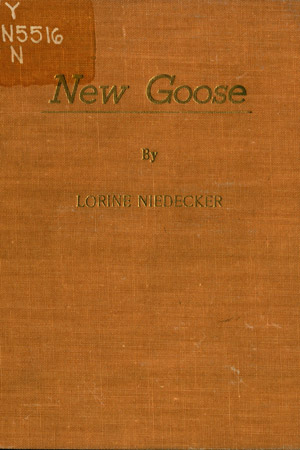
Cover of Niedecker’s New Goose
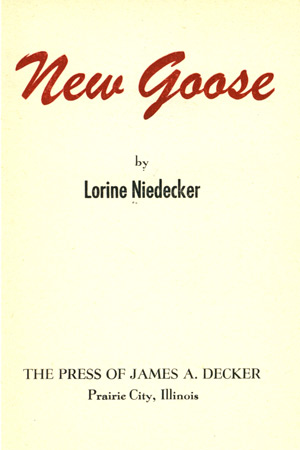
Title page of Niedecker’s New Goose.
New Goose
Beginning in 1935, and with encouragement from Zukofsky, Niedecker had begun work on a series of short, folk-speech inspired poems. Over the next decade she produced more than 80 of these poems, which she referred to as “Mother Geese/Goose” or “New Goose” poems, in homage to the folk tales and nursery rhymes associated with Mother Goose, an archetypal source of female folk wisdom. A great number of these were taken directly from conversations and historical records encountered while working in Madison for the Wisconsin Writers’ Project and other Works Project Administration programs between 1938 and April 1942. Although Niedecker first began seeking publication for these poems in 1936, when she unsuccessfully submitted a dozen “Mother Goose” poems to Poetry magazine in February, they would not be published in book form until March 1946, when the James A. Decker Press published New Goose, her first collection.17By the time the book was published, nearly 15 years had elapsed since Niedecker first read the ‘Objectivists’ in Poetry magazine and initiated her correspondence with Louis Zukofsky; she also had to wait eighteen months after submitting a corrected typescript of the book manuscript to the press before the book was printed. This would have offered Niedecker another painful lesson in patience and helps highlight the difficulty that nearly all of the “Objectivists” had in publishing their work, especially in their early careers. The James A. Decker Press was a small poetry-only press based in Prairie City, Illinois which had previously published books by well-known midwestern writers like Edgar Lee Masters and August Derleth, as well as books or anthologies by Zukofsky and his fellow “Objectivists” Norman Macleod, Harry Roskolenko, Charles Henri Ford.18Decker had collaborated with Exile’s Press to publish The Exiles’ Anthology, edited by Helen Neville and Harry Roskolenko, in 1940. The press printed Ford’s ABC’s in 1940, Zukofsky’s 55 Poems in 1941, and had published three annual anthologies edited by Macleod under the title Calendar between 1940 and 1942 as well as Macleod’s collection We Thank You All the Time in 1941. In 1941, Decker published Edgar Lee Masters’ Illinois Poems and printed his Selected Poems (edited by August Derleth) in 1944. Derleth’s own collections Rind of Earth and The Edge of Night, were published in 1942 and 1945, respectively. Zukofsky’s second collection, Anew, was also issued by the press shortly before Niedecker’s New Goose in 1946. The book itself, like many of the Decker poetry titles, was physically small (4 1/2 by 6 inches) but attractively printed, and contained 41 poems, nearly all of which were very short (the only poem longer than 16 lines was “Pioneers”).19Five of the poems had been previously published in New Directions and one had appeared in Furioso. Zukofsky had encouraged Niedecker to submit her manuscript to the press and via correspondence had also helped Niedecker prepare and edit the poems which she ultimately included in the final edition of the text.
“For Paul” Poems and the 1950s
In May 1944, Niedecker took a job as a stenographer and proofreader for Hoard’s, the printing company responsible for publishing Hoard’s Dairyman, an important regional agricultural trade publication. Following the publication of New Goose in 1946, Niedecker’s poetic output declined considerably for a few years. She moved out of her parents’ home into her own cabin on Blackhawk Island in 1946 and visited the Zukofskys in New York City in June 1947. It was on this trip that she first met Louis and Celia’s young son Paul, who had been born on October 22, 1943. In 1949, Niedecker began work on a numbered series of “For Paul” poems, and devoted herself to this sequence with greater energy following her resignation from Hoard’s (due to her deteriorating eyesight) in 1950. Niedecker and Zukofsky corresponded actively throughout the 1940s and 1950s, and by the end of 1956, she had shared a new book manuscript with Zukofsky and discussed the possibility of calling it For Paul.20In the letter she sent to Zukofsky in December 1956 accompanying the manuscript, she wrote: “Should the title be FOR PAUL?? Yes, I guess so. Nice if whenever it’s printed, Paul’s handwriting: AND I ACCEPT – PAUL. Suzz? If he does accept! !” (Niedecker and the Correspondence with Zukofsky, 230).
Zukofsky suggested several omissions and revisions, and Niedecker sent a revised manuscript made up of 41 poems to Jonathan Williams, Zukofsky’s contact at the Black Mountain Press on December 12, 1956. In a letter to Zukofsky written on the same day, Niedecker indicated that she was considering several alternate titles: Other Poems and For Paul, Forms for Paul, or even Fellow Matter, with the book being dedicated to Paul.21Niedecker and the Correspondence with Zukofsky, 231. Williams expressed interest in publishing Niedecker’s manuscript, but the financial burden that publishing the book would impose upon her and Zukofsky’s unwillingness to provide a forward eventually caused her to tell Williams she felt she “shouldn’t go ahead with the printing.”22Quoted in Truck 16 (Summer 1975). While she had offered $200-$300 towards publishing costs, she eventually shied away from the heavy expense that Williams was asking her to bear, confessing in a letter to Williams that “Poetry is the most important thing in my life but if sometime someone would print it without asking me for any money I’d feel it would be important to someone else also. … I think I spoke to you about printing a little too soon. I’m sorry. … P.S.: If you can print the poetry of Louis Zukofsky and the prose of Edward Dahlberg I’ll be content.”23Quoted in Truck 16 (Summer 1975), 44. In the end, Niedecker never did publish the “For Paul” manuscript as a book, though she sporadically published small batches of poems, some of which had been part of this manuscript, in little magazines during the 1950s.
In July 1951, Niedecker’s mother Daisy died. In 1951 and 1952, Niedecker wrote a series of unpublished prose and radio pieces. Her interest in the form appears to have begun with the composition of “Switchboard Girl,” a largely autobiographical short story about her struggle to find employment as a thoughtful, introverted single female with poor eyesight in a small Midwestern town. This piece was published in the New Directions anthology in 1951, though no other prose from this period appeared in print. Penberthy has collected pieces from three other projects, however: “The evening’s automobiles,” a brief and loosely autobiographical prose reflection about her life in Fort Atkinson shortly after leaving Hoard’s in which Niedecker adopts a male persona; “As I Lay Dying,” a 17-page radio adaptation of William Faulkner’s novel (never produced); and one surviving scene from “Taste and Tenderness,” a two-act radio script about the James family [Henry, William, Alice] that Niedecker sent to Zukofsky in 1952. [Quote from Niedecker’s letters to Zukofsky from this period?]
Niedecker visited the Zukofsky’s in New York City again for Christmas in 1953, and following her father Henry’s death in June 1954, Louis, Celia, and Paul visited her on Black Hawk Island that summer. Upon her father’s death, Niedecker inherited some property which provided her with both welcome rental income as well as the burden of ownership and the unwelcomed troubles of being a landlord. In January 1957, Niedecker wrote to Jonathan Williams of the burdens of property ownership and her search for employment: “Then too at the moment I’m involved in hot water heaters for my cottages, in drilling for a flowing well and in job hunting, the last named the greatest nightmare of all even when I find the job.”24Quoted in Niedecker and the Correspondence with Zukofsky, 131. On February 1, 1957, Niedecker began a new position as a cleaning person in the Dietary Unit at the Fort Atkinson Memorial Hospital. Her janitorial work at the hospital made considerable demands on her time and energy leaving her only the weekends for reading and writing. Her heavy work schedule dramatically curtailed her poetic production, particularly during her first few years in the job, though she had not exactly been prolific in the decade previous.25Margot Peters, her biographer, suggests that a typical workday schedule would have been rising at 5 am, leaving home by 6:15 am and returning from work around 5 pm. See Lorine Niedecker: A Poet’s Life, 126.
When Robert Creeley accepted four poems for inclusion in the Spring 1956 issue of the Black Mountain Review, for instance, she wrote excitedly to Edward Dahlberg: “Creeley has now accepted 4. I’m almost overcome, this would make my 6th publication in 10 years!”26Quoted in https://www.asu.edu/pipercwcenter/how2journal/archive/online_archive/v1_7_200/current/readings/penberthy.htm. The five previous publications she referred to in this letter were appearances in New Directions‘ annual anthologies (she published poems in both the 1949 and 1950 anthologies, and published “Switchboard Girl,” a prose piece, in the 1951 anthology); poems published in the Summer 1950 and Spring 1951 issues of the New Mexico Quarterly, where Edwin Honig was the poetry editor;27These can now be read online at http://digitalrepository.unm.edu/cgi/viewcontent.cgi?article=3087&context=nmq and http://digitalrepository.unm.edu/cgi/viewcontent.cgi?article=3198&context=nmq. “Woman with Umbrella,” a short poem published in the Spring 1953 issue of Accent, a quarterly magazine published out of the University of Illinois and edited by Kerker Quinn and Charles Shattuck; and the publication of a cluster of “For Paul” poems in the Quarterly Review of Literature in 1955.28Of these poems, Niedecker wrote to Zukofsky on September 29, 1955: “I’m not too pleased with the looks of the mag For Paul is in. The poets in it seem too “educated” and sophisticated. It used to be a large periodical with prose and book reviews.’ Will have him send you one – or should I send it to Paul – well, both of you and all of you and those are my best in many years because they’re about something real and good and human. I’ve lost something since then, need subjects now to focus on. Now Zu, the last poem’ in this group [“They Live a Cool Distance,” which can be found in Collected Works, 160-161.] you may frown on but I was only trying to be honest. Remember that when you read it. Very difficult problem to state – I feel I haven’t yet got it all, left out maybe: their love of this thing. The stoic enters in but is only one aspect. I hope the poem doesn’t get over just the one idea that it’s a principle. It’s a compulsion to express thru difficulties, a love of the thing. At any rate, don’t set it up between us” (Niedecker and the Correspondence with Zukofsky, 224). Even this small trickle slowed considerably after she began working as a cleaning woman, however. Following her appearance in Black Mountain Review in 1956, Niedecker’s only other publication for the next five years was the publication of a few poems in a 1959 issue of the Gilbert Sorrentino’s little magazine Neon.
The 1960s
1960, however, marked the beginning of the most significant decade of Niedecker’s poetic career, made notable especially by her introduction to publishers and champions as far afield as rural North Carolina (Jonathan Williams), Scotland (Ian Hamilton Finlay) and Japan (Cid Corman). Two events near the beginning of the decade played particularly important roles in her late-career flourishing. In September 1960, Niedecker wrote to Cid Corman for the first time, beginning a publishing relationship and epistolary friendship that would have a significant impact on both Niedecker’s late years and her posthumous reception. The second was her ‘discovery’ and publication by the poet, artist, and publisher Ian Hamilton Finlay, then working from Edinburgh, Scotland.
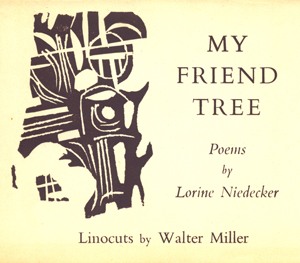
Cover of Niedecker’s My Friend Tree
My Friend Tree
In 1961, the Scottish artist Ian Hamilton Finlay published Niedecker’s second book, My Friend Tree, through his Wild Hawthorn Press in Edinburgh, Scotland. My Friend Tree interspersed 16 of Niedecker’s poems (more than half of which had previously appeared in New Goose) with a series of abstract linocuts made by the English artist Walter Miller, who also designed the book’s layout. As for paratext, the book included only a loose sheet one-page introduction by the poet Ed Dorn, who began by stating that “These sounds mark the placements of an inner world,” and concluded by observing that “I like these poems because first they attach an undistractable clarity to the word, and then because they are unabashed enough to weld that word to a freely sought, beautifully random instance … the catch in the seine.” Though My Friend Tree was a very small book with a limited print run, its publication and Niedecker’s inclusion in four of the first thirteen issues of Poor.Old.Tired.Horse, Hamilton Finlay’s influential magazine of visual poetry, did much to establish Niedecker as a poet of interest among sympathetic readers in the United Kingdom. Most importantly for her later career, her publication by Finlay brought her to the attention of Stuart and Deirdre Montgomery, proprietors of Fulcrum Press, who would go on to publish two of her collections later in the decade.29Niedecker had poems included in issues 1, 4, 9, and 13 of POTH (links lead to PDF files hosted at UBU web).
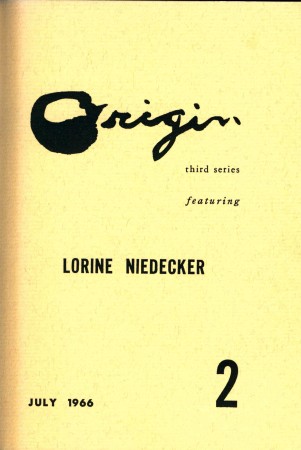
Cover of July 1966 issue of Origin magazine (third series, issue 2).
Cid Corman and Origin Magazine
Equally important for Niedecker’s publication history was her epistolary friendship with Cid Corman, which led to her regular publication in Corman’s little magazine Origin and Corman’s tireless championing of Niedecker’s work until his death in 2004.30More than 100 letters from Niedecker to Corman survive, meaning that Niedecker averaged almost a letter a month to Corman over the decade of their correspondence. Niedecker initiated the relationship, as she had nearly 30 years earlier with Zukofsky, writing to Corman on September 6, 1960, telling him that Zukofsky had encouraged her to send Corman her own work, offering a set of seven short poems, and indicating that she was eager to see the forthcoming publication of Zukofsky’s “A”-13 in Corman’s newly-resumed Origin.
Corman accepted Niedecker’s poems for publication, and Niedecker wrote Corman an additional seven letters before the end of 1961, enclosing money to support Corman’s publishing efforts in several of these letters. Corman included work by Niedecker in ten different issues of Origin, and listed her on the cover as the featured author of the issue on two occasions.31A full list of Niedecker’s Origin appearances is as follows: 2.2, July 1961 (Nine poems); 2.6, July 1962 (“The men leave” and “The wild and wavy event”); 2.8, January 1963 (Five poems); 3.2, July 1966 (She appeared as the featured poet and the issue included 38 poems and excerpts from 5 letters); 3.7, October 1967 (HEAR & SEE [11 poems]); 3.9, April 1968 (eleven poems); 3.12, January 1969 (“L.Z.”); 3.19, October 1970 (9 poems, including “His Carpets Flowered” and “Thomas Jefferson”) 4.1, October 1977 (“Darwin”); and 4.16, July 1981 (Her second appearance as the featured poet, this issue featured 48 pages of Niedecker-related material, including a biography by Jane Knox, 9 poems and some excerpts from notes and letters). In November 1970, just two weeks before Niedecker sustained the sudden cerebral hemorrhage which eventually claimed her life, Corman and his wife Shizumi visited Niedecker and her husband Al Millen at their home on Blackhawk Island, at which time Corman made the only known recording of Niedecker reading her poetry (included below).
Other Magazine Publications in the 1960s
In addition to her budding relationship with new publishers, the other major change that impacted Niedecker’s poetic output was domestic. On May 24, 1963, Niedecker married Al Millen, a one-armed industrial painter from Milwaukee she met a few months previously when he had purchased one of her Blackhawk Island properties as a retirement cabin. In November, Lorine retired from her cleaning position at Fort Atkinson Memorial Hospital and moved to Al’s apartment in Milwaukee in December of 1963. Freed from the burdens of property management and full-time employment by her marriage to Al, Niedecker devoted much of her new-found time and leisure to poetry. In addition to her publications with Corman (in Origin) and Finlay (in Poor.Old.Tired.Horse), Niedecker also found wider circulation for her work as the “Objectivists” began to emerge to greater public notice, publishing poems in the well-known magazines Poetry, Granta, and the Paris Review as well as a range of small magazines being published by a generation of admiring younger American poets. Niedecker published three poems in the August 1963 issue of Poetry (nearly 30 years after her first appearance in the magazine!), two poems in the Summer/Fall 1964 issue of the Paris Review, three poems in the 1964/1965 issue of the old Granta magazine, five poems in the August 1965 issue of Poetry, a single poem, “Who Was Mary Shelley,” in the Winter 1966 issue of the Paris Review, and four poems in the December 1967 issue of Poetry. She also published work in the inaugural issue of Clark Coolidge and Michael Palmer’s Joglars (which appeared in Spring 1964); in Arts in Society (published at the University of Wisconsin-Milwaukee and edited by Morgan Gibson) in 1965 and 1967; had 8 poems in the first issue of Thomas Merton’s Monk’s Pond (Spring 1968); published her long poem “Wintergreen Ridge” in the April-July 1968 issue of Clayton Eshleman’s Caterpillar; published “Paean to Place” and a handful of shorter poems appeared in George Quasha and Roger Guedella’s large “America: A Prophecy” Stony Brook anthology in 1969; and two short poems in the June 1970 issue of Mike Doyle’s Tuatara. Eliot Weinberger also published a few Niedecker poems posthumously in the Summer 1976 issue of Montemora.
Late-Career Niedecker
While Lorine’s marriage to Al enabled a late-career fluorescence of poetic production, reliable publication continued to be elusive. In 1968, when L.S. Dembo arranged for the interviews and campus readings by Zukofsky, Oppen, Reznikoff, and Rakosi that eventually marked the ‘rediscovery’ of the ‘Objectivists’ by the academy, Niedecker still had published just two slim volumes, one of which had appeared more than 20 years previously, and the other an obscure artist’s book printed by an eccentric Scotsman. All told, the total output she had published in books bearing her name comprised fewer than 75 pages, and was mostly comprised of tiny poems generally no longer than 8-10 lines each. The remainder of her publications had been confined to little magazines, with the exception of about twenty poems that had been published in Poetry and The Paris Review. While we might lament Dembo’s lost opportunity and perhaps even suspect him of gender bias, based on Niedecker’s then extant publications it’s difficult to see how Dembo could have properly considered Niedecker to be the significant poet we now know her to be absent significant prompting from Zukofsky, the only person Dembo had contact with that had a fair sense of her poetic talents and the full range of her (then largely unpublished) oeuvre. Unfortunately for Niedecker, Zukofsky’s relationship to his former “Objectivist” peers was quite cold at this point. Still smarting from the hurt of his own long-standing neglect, he had little interest in publicly promoting the work of others. Despite Dembo’s “oversight,” 1968 was still an auspicious year for both the “Objectivists” generally and for Niedecker in particular, marking the beginning of a flurry of significant publishing activity for her.32In addition to being the year that Dembo began the process reconstructing the Objectivist nexus as a formation of interest for the study of 20th century American poetry, 1968 was also the year that Oppen published Of Being Numerous, which was a surprise winner of the Pulitzer Prize in Poetry.
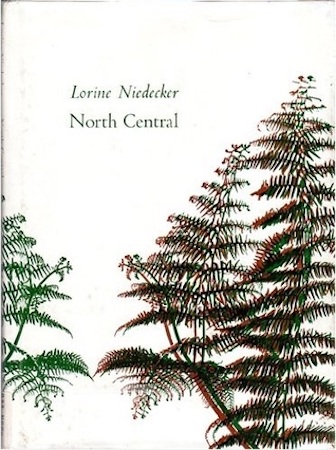
Cover of Niedecker’s North Central
North Central
This intense burst of publication began with North Central, published in London by Stuart and Deirdre Montgomery’s Fulcrum Press. Immediately upon its publication, it was clear that North Central was (and remains) the most significant of Niedecker’s poetry collections. For one, it was by far the longest and most ambitious collection she had published, as well as having by far the largest print run (with over 5000 copies printed). While the book enjoyed some success in England, it wouldn’t be until the publication of her T & G: Collected Poems 1936-1966 that Niedecker’s work from two decades following the publication of New Goose became available in her native country.
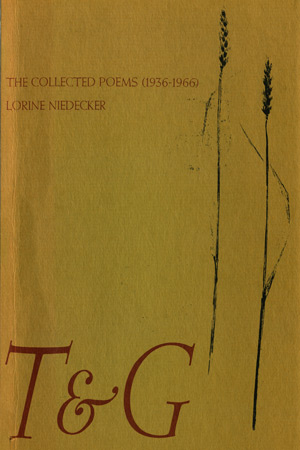
Cover of Niedecker’s T & G: The Collected Poems (1936-1966)
T & G: The Collected Poems (1936-1966)
T & G was published from Penland, North Carolina by Jonathan Williams in an original edition of 2000. The book bore the imprimatur of Williams’ Jargon Society (which he maintained by subscription) and was sent to his subscribers as Jargon 48. The book was handsomely composed and printed and was decorated with several plant prints made by A. Doyle Moore, an accomplished artist who taught graphic design at the University of Illinois for many years. For all the book’s beauty, however, its journey to publication had been neither easy nor placid, as the perpetually nomadic and underfunded Williams had delayed publication for several years, worrying and exasperating Niedecker a great deal and causing her to seriously doubt whether the book would ever appear at all.
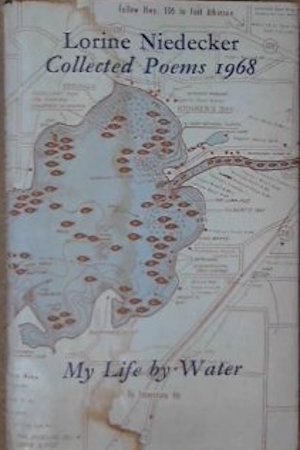
Cover of Niedecker’s My Life by Water: Collected Poems 1936-1968
My Life by Water: Collected Poems 1936-1968
In 1970, Fulcrum Press published their own collected Niedecker in England. Their collection, My Life by Water: Collected Poems 1936-1968, comprised most of Niedecker’s poetic output from the years circumscribed, and was the last book published during Niedecker’s lifetime, as she died unexpectedly on December 31, 1970, aged 67.
Posthumous Publications
In the two decades immediately following her death, three new books appeared, thanks to the continued efforts and advocacy of Cid Corman and Jonathan Williams.
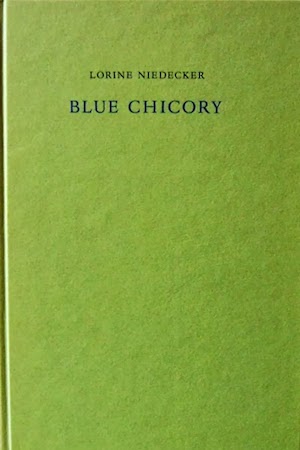
Cover of Niedecker’s Blue Chicory, edited by Cid Corman.
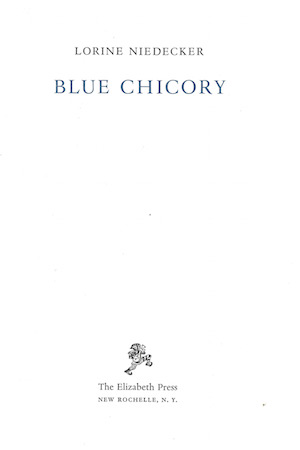
Title page of Niedecker’s Blue Chicory
Blue Chicory
The first posthumous Niedecker collection was the Corman-edited Blue Chickory, published by James Weil’s Elizabeth Press in 1976. Blue Chicory included several poems which were uncollected or in manuscript form at the time of Niedecker’s death.
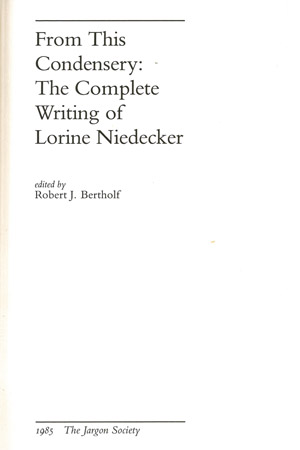
Title page of Niedecker’s From this Condensery: The Complete Writing of Lorine Niedecker, edited by Robert J. Bertholf.
From this Condensery
In 1985, two collections appeared which attempted to take a broad, comprehensive view of Niedecker’s career output. Williams’ Jargon Society printed From this Condensery, a collected edited by Robert J. Bertholf which he sent to subscribers as Jargon 100. This collection purported to be “The Complete Writings of Lorine Niedecker,” and while extensive (at over 330 pages), the book suffered from major editorial flaws, necessitating its replacement as the definitive record of Niedecker’s career output by Jenny Penberthy’s Collected Works (published in 2002). In addition to the hardcover edition, Williams also produced a special leather-bound “Patrons Edition” comprised by 100 copies signed by Williams and Bertholf.
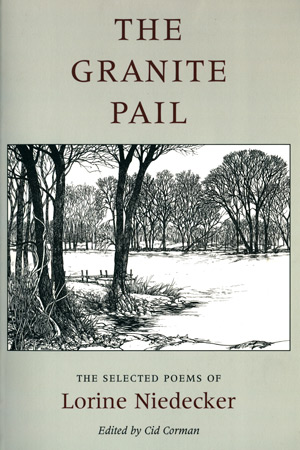
Cover of Niedecker’s The Granite Pail, edited by Cid Corman (revised second edition).
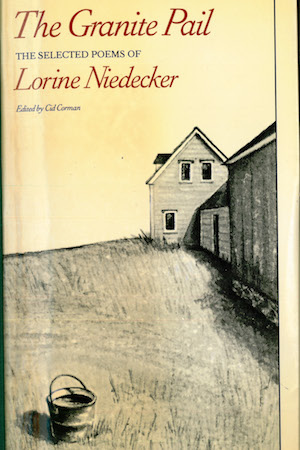
Cover of Niedecker’s The Granite Pail, edited by Cid Corman (first edition).
The Granite Pail: The Selected Poems of Lorine Niedecker
The same year, Corman published a selection of Niedecker’s poems under the title The Granite Pail: The Selected Poems of Lorine Niedecker with Jack Shoemaker’s North Point Press. The book was the first posthumous attempt at a selected poems, and contained work from each of Niedecker’s previously published books, with more extensive selections made from work Corman had previously selected for publication. The North Point Press ceased publishing books in 1991, but Corman published out a revised edition of The Granite Pail with Jonathan Greene’s Gnomon Press in 1996.
Jenny Penberthy’s Editorial Care
While Williams and Corman were invaluable in bringing Niedecker’s work to wider attention, the most important event for Niedecker’s current standing and reputation was her discovery by Jenny Penberthy in the early 1980s. Penberthy became interested in Niedecker after reading Basil Bunting’s praise for her as “one of the finest American poets of all, besides being easily the finest female American poet.” 33See Penberthy’s “Acknowledgements” in Niedecker and the Correspondence with Zukofsky, xiii. Penberthy subsequently became the world’s leading authority on Niedecker’s poetry, carefully editing and publishing Niedecker and the Correspondence with Zukofsky 1931-1970 in 1993; Lorine Niedecker: Woman and Poet, a collection of essays, letters, and biographical remembrances published in 1996 by the National Poetry Foundation; and three collections of poetry, including Collected Works, the definitive collection of Niedecker’s writing, published in 2002 by the University of California Press.
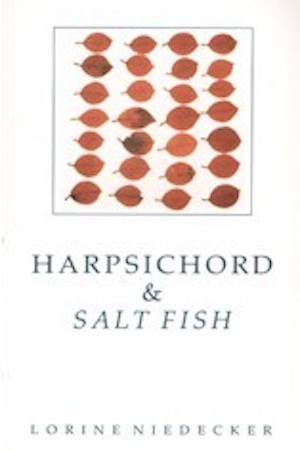
Cover of Niedecker’s Harpsichord and Salt Fish.
Harpsichord & Salt Fish
Penberthy’s superlative contribution to Niedecker textual scholarship began in 1991 with the appearance of Harpsichord & Salt Fish. This book was based on a manuscript that Niedecker had completed and sent to James Laughlin’s New Directions Press in 1970, but which New Directions had declined to publish. Penberthy recovered the manuscript through her archival research, however, and printed the collection with Ric and Anne Caddel’s Pig Press in Durham, England.
Penberthy followed this initial foray with Niedecker and the Correspondence with Zukofsky 1931-1970, a carefully edited and thoroughly documented account of the Niedecker-Zukofsky relationship which includes nearly three-quarters of the surviving letters from Niedecker to Zukofsky, published by Cambridge University Press in 1993. This book was a remarkable scholarly accomplishment which had been made particularly difficult by large gaps in their surviving correspondence and the notorious reluctance of Paul Zukofsky to allow republication of his father’s words.
In 2002, Penberthy published two Niedecker-related books: a reordered edition of Niedecker’s New Goose poems, many of which had been previously unpublished, with the Berkeley, California based imprint Listening Chamber, and the monumental Collected Works published by the University of California Press.
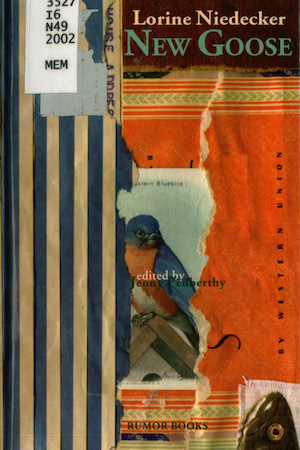
Cover of Niedecker’s New Goose (2002 edition), edited by Jenny Penberthy.
New Goose (2002)
Penberthy’s 2002 edition of New Goose includes all 86 of the known poems which survive from the decade during which Niedecker was writing her Mother Goose poems (1935-1945).
Collected Works
Penberthy’s Collected Works is a meticulously edited, authoritative record of Niedecker’s career literary output. Rooted in deep archival research, it corrected a number of egregious errors perpetuated by Bertholf’s From This Condensery, including a far more accurate title (Collected Works rather than The Complete Writing). Penberthy published a small collection of errata to the edition on Jacket2 in 2013.
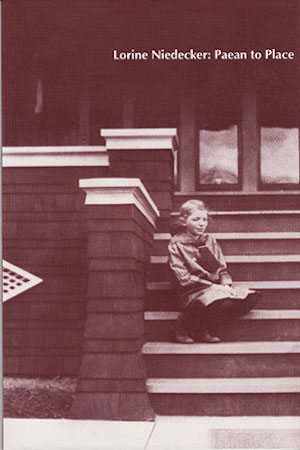
Cover of Niedecker’s Paean to Place
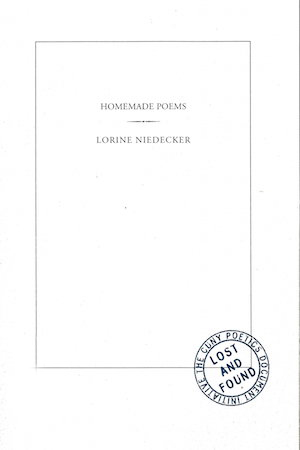
Cover of Niedecker’s Homemade Poems, edited by John Harkey.
Autograph Editions of Niedecker’s Handmade Works
In the years following Niedecker’s death, a handful of publications have reprinted various portions of Niedecker’s total output with various contextual paratext. The first of these, A Cooking Book, was published by Bob Arnold’s Longhouse Press in 1992, and consists of facsimile reproductions of a handmade, lighthearted cookbook Niedecker made as a Christmas gift for her friend Maude Hartel in 1964.34A digitized scan of the copy that Niedecker gave to Maude has been digitized by the University of Wisconsin Digital Collections and can be viewed online. To celebrate the hundredth anniversary of Niedecker’s birthday in 2003, the Woodland Pattern bookshop and Karl Young’s Light & Dust collaborated to print Paean to Place, an autograph edition of a handmade book Niedecker made in August 1969 for her friend Florence Dollase. In 2012, John Harkey edited Homemade Poems, an autograph reproduction of one of the three handmade gift books Niedecker made in late 1964 for Cid Corman, Jonathan Williams, and Louis Zukofsky published as part of the Center for the Humanities at CUNY’s “Lost and Found” series.
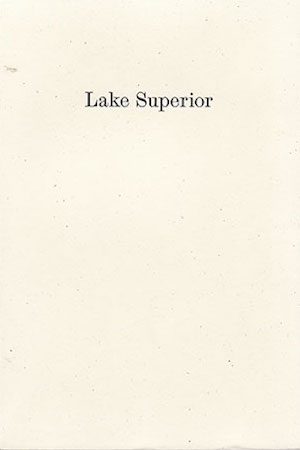
Cover of Niedecker’s Lake Superior.
Lake Superior
In 2013, Wave Books published Lake Superior, which was comprised of the original poem, some 20+ pages of notes from Niedecker’s journal surrounding the circle tour she and her husband Al Millen made to see Lake Superior in 1966, and 60+ pages of additional contextual material relevant to the poem.
Publication Timeline
Poetry

 New Goose. Prairie City, Ill.: Press of James A. Decker, 1946. Library.
New Goose. Prairie City, Ill.: Press of James A. Decker, 1946. Library. My Friend Tree. Edinburgh: Wild Hawthorne Press, 1961. Library. [introduction by Ed Dorn]
My Friend Tree. Edinburgh: Wild Hawthorne Press, 1961. Library. [introduction by Ed Dorn]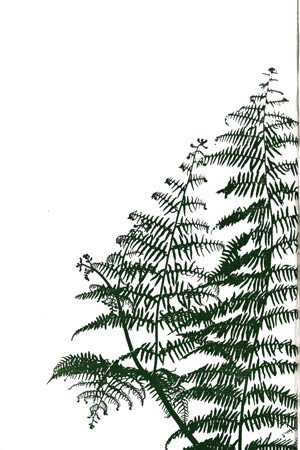
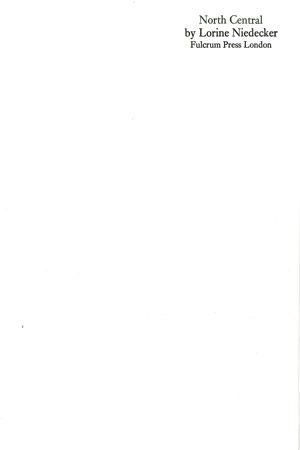 North Central. London: Fulcrum Press, 1968. Library.
North Central. London: Fulcrum Press, 1968. Library. T & G: Collected Poems 1936-1966. Penland, N.C.: Jargon Society, 1969. Library.
T & G: Collected Poems 1936-1966. Penland, N.C.: Jargon Society, 1969. Library.
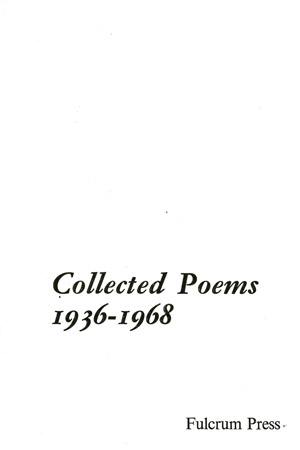 My Life By Water: Collected Poems 1936-1968. London: Fulcrum Press, 1970. Library.
My Life By Water: Collected Poems 1936-1968. London: Fulcrum Press, 1970. Library. Blue Chicory. Ed. Cid Corman, New Rochelle, N.Y.: The Elizabeth Press, 1976. Library.
Blue Chicory. Ed. Cid Corman, New Rochelle, N.Y.: The Elizabeth Press, 1976. Library. From This Condensery: The Complete Writings of Lorine Niedecker. Ed. Robert J. Bertholf, East Haven, Connecticut: Jargon Society/Inland Book Company, 1985. Library.
From This Condensery: The Complete Writings of Lorine Niedecker. Ed. Robert J. Bertholf, East Haven, Connecticut: Jargon Society/Inland Book Company, 1985. Library. The Granite Pail: Selected Poems of Lorine Niedecker. Ed. Cid Corman, San Francisco: North Point Press, 1985. Library | Publisher.
The Granite Pail: Selected Poems of Lorine Niedecker. Ed. Cid Corman, San Francisco: North Point Press, 1985. Library | Publisher. Harpsichord & Salt Fish, Ed. Jenny Penberthy. Durham, N.C.: Pig Press, 1991. Library.
Harpsichord & Salt Fish, Ed. Jenny Penberthy. Durham, N.C.: Pig Press, 1991. Library. New Goose. Ed. Jenny Penberthy. Berkeley: Listening Chamber, 2002. Library | Publisher
New Goose. Ed. Jenny Penberthy. Berkeley: Listening Chamber, 2002. Library | Publisher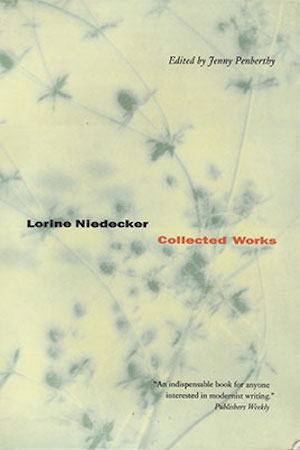 Collected Works. Ed. Jenny Penberthy. Berkeley: University of California Press, 2002. Library | Publisher.
Collected Works. Ed. Jenny Penberthy. Berkeley: University of California Press, 2002. Library | Publisher. Paean to Place. Ed. Cid Corman. Light and Dust, 2003. Library | Publisher.
Paean to Place. Ed. Cid Corman. Light and Dust, 2003. Library | Publisher. Homemade Poems. Ed. John Harkey. New York: Center for the Humanities, Graduate Center, City University of New York, 2012. Library | Publisher.
Homemade Poems. Ed. John Harkey. New York: Center for the Humanities, Graduate Center, City University of New York, 2012. Library | Publisher. Lake Superior, Seattle: Wave Books, 2013. Library | Publisher.
Lake Superior, Seattle: Wave Books, 2013. Library | Publisher.
Correspondence
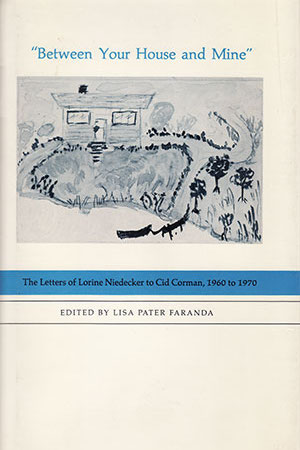 Between Your House and Mine: Letters of Lorine Niedecker to Cid Corman, 1960-1970. Ed. Lisa Pater Faranda. Durham, N.C.: Duke University Press, 1986. Library | Publisher.
Between Your House and Mine: Letters of Lorine Niedecker to Cid Corman, 1960-1970. Ed. Lisa Pater Faranda. Durham, N.C.: Duke University Press, 1986. Library | Publisher.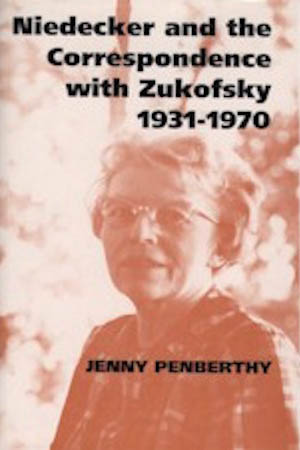 Niedecker and the Correspondence with Zukofsky 1931-1970. Ed. Jenny Penberthy. Cambridge: Cambridge University Press, 1993. Library.
Niedecker and the Correspondence with Zukofsky 1931-1970. Ed. Jenny Penberthy. Cambridge: Cambridge University Press, 1993. Library.
References
| ↑1 | For more details on this time in Niedecker’s life, see Lorine Niedecker: A Poet’s Life, pp. 19-25. For further details of her interest in poetry while at Beloit College, see Beloit College archivist Fred Burwell’s brief notes at https://perma.cc/W6QP-7UX4. |
|---|---|
| ↑2 | Zukofsky would famously complain in the “‘Recencies’ in Poetry” address which prefaced An ‘Objectivists’ Anthology: “The “objectivists” number of Poetry appeared in February. Since then there have been March, April, May, June, July and we are now past the middle of August. Don’t write, telegraph.” (22) Given that Niedecker later dated her first letter to Zukofsky as being sent in August or September of that year, its timing was probably most welcome to the somewhat deflated erstwhile ‘Objectivist’ impresario. |
| ↑3 | This date of acceptance is established by later letter, but Niedecker’s reply, dated July 5, 1932, instructed Monroe to keep whatever money would normally be due to her for the publication of the poem and merely send her two copies of the issue in which the poem would appear. |
| ↑4 | Archive of Pagany, University of Delaware Special Collections, Box 1, Folder 174. |
| ↑5 | ”Progression” was able to be included in Jenny Penberthy’s Collected Works only because Burton Hatlen found a separate draft of the poem sent to Ezra Pound in January 1934 while searching among the Ezra Pound papers in 1995. See Collected Works, 25-32, 369-370. |
| ↑6 | Archive of Pagany, University of Delaware Special Collections, Box 1, Folder 174. |
| ↑7 | Niedecker’s letter reads, in full: “Enclosed is “When Ecstasy is Inconvenient” accepted by Miss Monroe in January ’32 and since mislaid. May I mention again, though I think Miss Monroe knows, I should like the poem, this one and the one just lately accepted printed under the name Lorine Niedecker, rather than Lorine Hartwig or Mrs. Frank Hartwig.” (Poetry, A Magazine of Verse Papers, University of Chicago Special Collections, Box 18, Folder 2). |
| ↑8 | Niedecker had apparently rejected Monroe’s suggestion of the heading “SOMNAMBULISTIC JOURNEY” (Collected Works, 369). |
| ↑9 | The full September 1933 issue of Poetry can be read online at https://www.poetryfoundation.org/poetrymagazine/issue/70569/september-1933. |
| ↑10 | Poetry, A Magazine of Verse Papers, University of Chicago Special Collections, Box 18, Folder 2. |
| ↑11 | Poetry, A Magazine of Verse Papers, University of Chicago Special Collections, Box 18, Folder 2. |
| ↑12 | Poetry, A Magazine of Verse Papers, University of Chicago Special Collections, Box 18, Folder 2. |
| ↑13 | Poetry, A Magazine of Verse Papers, University of Chicago Special Collections, Box 18, Folder 2. |
| ↑14 | This magazine, published out of Atlanta’s Oglethorpe University, was formed in 1935 with the merger of Bozart and Contemporary Verse (the title punning on the term ‘beaux arts’) and The Westminster Magazine and continued publication under the combined title until 1938, when it reverted to the simpler Westminster title. |
| ↑15 | Zukofsky wrote Pound on February 17, 1935: “Glad you agreed with me as to the value of Lorine Niedecker’s work and are printing it in Westminster.” Pound replied on March 6: “I don’t think yr/ Niedecker is so hot/ thought he was a lady ANYhow. . Lorine . . . ?? [Pound was confused as to Niedecker’s gender by his misreading of a reference Zukofsky had made in a previous letter] It got by, because I printed one tadpole on each recommendation of qualified critics/ (i;e; more or less. . qualified.) I can’t hold the boat FOR you.” Zukofsky’s reply, dated March 15, replies: “There’s no use wasting yr. time calling me down about surrealisme—if you had read Mantis, An Interpretation, you’d have found I think pretty much as you do about surrealisme—but you haven’t read it. Nor have I swallowed Miss Niedecker’s mental stubborness [sic]. However, her output has some validity, some spark of energy, which the solipsistic daze=maze of Mr. Kummings hath not” (Pound/Zukofsky, 161-165). |
| ↑16 | The poems published in 1936 were “The President of the Holding Company”, “Fancy Another Day Gone”, and seventeen short poems published under the heading “Mother Geese.” These poems would remain uncollected in book form until their appearance in the Jenny Penberthy-edited Collected Works in 2002. |
| ↑17 | By the time the book was published, nearly 15 years had elapsed since Niedecker first read the ‘Objectivists’ in Poetry magazine and initiated her correspondence with Louis Zukofsky; she also had to wait eighteen months after submitting a corrected typescript of the book manuscript to the press before the book was printed. This would have offered Niedecker another painful lesson in patience and helps highlight the difficulty that nearly all of the “Objectivists” had in publishing their work, especially in their early careers. |
| ↑18 | Decker had collaborated with Exile’s Press to publish The Exiles’ Anthology, edited by Helen Neville and Harry Roskolenko, in 1940. The press printed Ford’s ABC’s in 1940, Zukofsky’s 55 Poems in 1941, and had published three annual anthologies edited by Macleod under the title Calendar between 1940 and 1942 as well as Macleod’s collection We Thank You All the Time in 1941. In 1941, Decker published Edgar Lee Masters’ Illinois Poems and printed his Selected Poems (edited by August Derleth) in 1944. Derleth’s own collections Rind of Earth and The Edge of Night, were published in 1942 and 1945, respectively. Zukofsky’s second collection, Anew, was also issued by the press shortly before Niedecker’s New Goose in 1946. |
| ↑19 | Five of the poems had been previously published in New Directions and one had appeared in Furioso. |
| ↑20 | In the letter she sent to Zukofsky in December 1956 accompanying the manuscript, she wrote: “Should the title be FOR PAUL?? Yes, I guess so. Nice if whenever it’s printed, Paul’s handwriting: AND I ACCEPT – PAUL. Suzz? If he does accept! !” (Niedecker and the Correspondence with Zukofsky, 230). |
| ↑21 | Niedecker and the Correspondence with Zukofsky, 231. |
| ↑22 | Quoted in Truck 16 (Summer 1975). |
| ↑23 | Quoted in Truck 16 (Summer 1975), 44. |
| ↑24 | Quoted in Niedecker and the Correspondence with Zukofsky, 131. |
| ↑25 | Margot Peters, her biographer, suggests that a typical workday schedule would have been rising at 5 am, leaving home by 6:15 am and returning from work around 5 pm. See Lorine Niedecker: A Poet’s Life, 126. |
| ↑26 | Quoted in https://www.asu.edu/pipercwcenter/how2journal/archive/online_archive/v1_7_200/current/readings/penberthy.htm. |
| ↑27 | These can now be read online at http://digitalrepository.unm.edu/cgi/viewcontent.cgi?article=3087&context=nmq and http://digitalrepository.unm.edu/cgi/viewcontent.cgi?article=3198&context=nmq. |
| ↑28 | Of these poems, Niedecker wrote to Zukofsky on September 29, 1955: “I’m not too pleased with the looks of the mag For Paul is in. The poets in it seem too “educated” and sophisticated. It used to be a large periodical with prose and book reviews.’ Will have him send you one – or should I send it to Paul – well, both of you and all of you and those are my best in many years because they’re about something real and good and human. I’ve lost something since then, need subjects now to focus on. Now Zu, the last poem’ in this group [“They Live a Cool Distance,” which can be found in Collected Works, 160-161.] you may frown on but I was only trying to be honest. Remember that when you read it. Very difficult problem to state – I feel I haven’t yet got it all, left out maybe: their love of this thing. The stoic enters in but is only one aspect. I hope the poem doesn’t get over just the one idea that it’s a principle. It’s a compulsion to express thru difficulties, a love of the thing. At any rate, don’t set it up between us” (Niedecker and the Correspondence with Zukofsky, 224). |
| ↑29 | Niedecker had poems included in issues 1, 4, 9, and 13 of POTH (links lead to PDF files hosted at UBU web). |
| ↑30 | More than 100 letters from Niedecker to Corman survive, meaning that Niedecker averaged almost a letter a month to Corman over the decade of their correspondence. |
| ↑31 | A full list of Niedecker’s Origin appearances is as follows: 2.2, July 1961 (Nine poems); 2.6, July 1962 (“The men leave” and “The wild and wavy event”); 2.8, January 1963 (Five poems); 3.2, July 1966 (She appeared as the featured poet and the issue included 38 poems and excerpts from 5 letters); 3.7, October 1967 (HEAR & SEE [11 poems]); 3.9, April 1968 (eleven poems); 3.12, January 1969 (“L.Z.”); 3.19, October 1970 (9 poems, including “His Carpets Flowered” and “Thomas Jefferson”) 4.1, October 1977 (“Darwin”); and 4.16, July 1981 (Her second appearance as the featured poet, this issue featured 48 pages of Niedecker-related material, including a biography by Jane Knox, 9 poems and some excerpts from notes and letters). |
| ↑32 | In addition to being the year that Dembo began the process reconstructing the Objectivist nexus as a formation of interest for the study of 20th century American poetry, 1968 was also the year that Oppen published Of Being Numerous, which was a surprise winner of the Pulitzer Prize in Poetry. |
| ↑33 | See Penberthy’s “Acknowledgements” in Niedecker and the Correspondence with Zukofsky, xiii. |
| ↑34 | A digitized scan of the copy that Niedecker gave to Maude has been digitized by the University of Wisconsin Digital Collections and can be viewed online. |